Abstract
The ionic requirements for entry of Shiga toxin into cells were examined by measuring inhibition of protein synthesis after short-term incubations with toxin. The sensitivity of Vero cells and HeLa cells to Shiga toxin was strongly dependent on the divalent cation present. Vero cells were most sensitive in the presence of CaCl2 and SrCl2, whereas HeLa cells were equally sensitive in the presence of MgCl2, SrCl2, and CaCl2. Both cell lines were protected by BaCl2, CoCl2, and MnCl2. Inhibitors of Ca2+ transport, like verapamil, D600, and Co2+ as well as the calcium-ionophores A23187 and ionomycin, protected both cell lines. HEp-2 cells were protected against Shiga toxin by a high concentration of potassium in the medium as well as by potassium depletion of the cells. Substitution of chloride in the medium with slowly permeable anions, like SO42- and SCN-, protected the cells against Shiga toxin. High concentrations of the ionophore nigericin that increase pH of acidic intracellular vesicles did not protect Vero cells against Shiga toxin. Shiga Toxin X-114 at pH values below 4.5. This binding was shifted to higher pH values after pretreatment of the toxin with dithiothreitol. The results indicate that Ca2+ transport through physiologically occurring Ca2+ channels is required for entry of Shiga toxin into cells. Furthermore, the sensitivity of cells of Shiga toxin is strongly dependent on the anions present.
Full text
PDF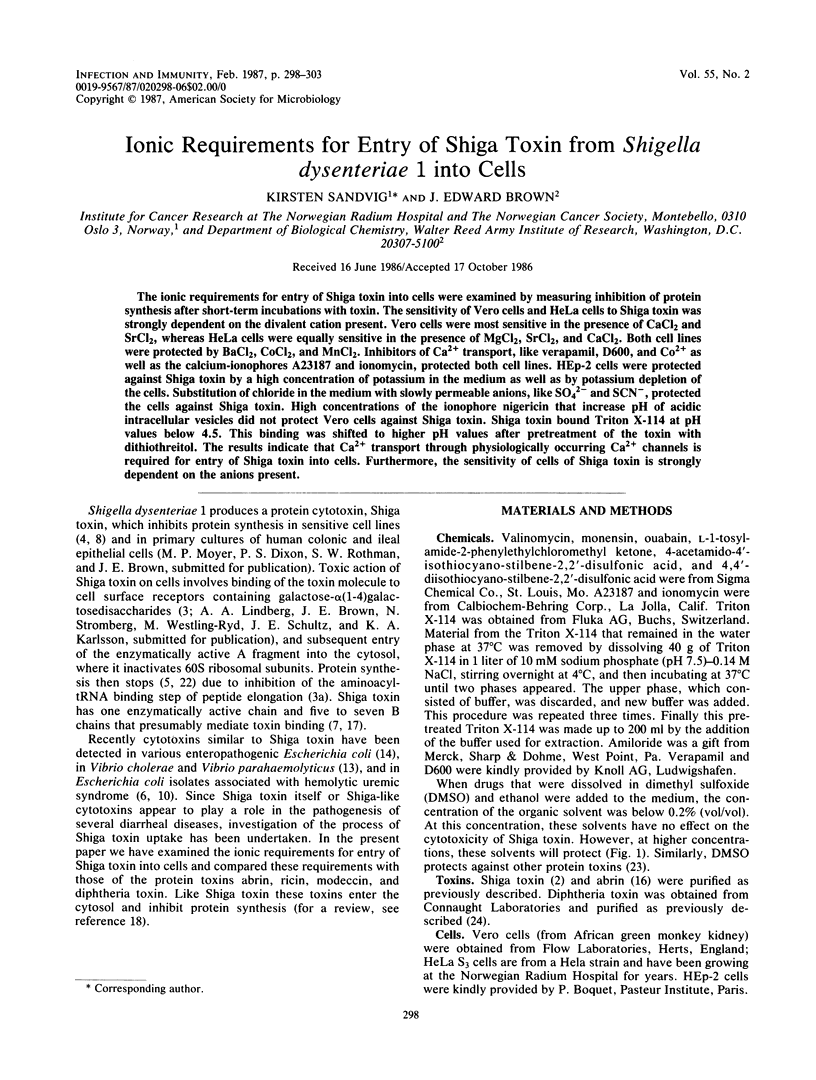
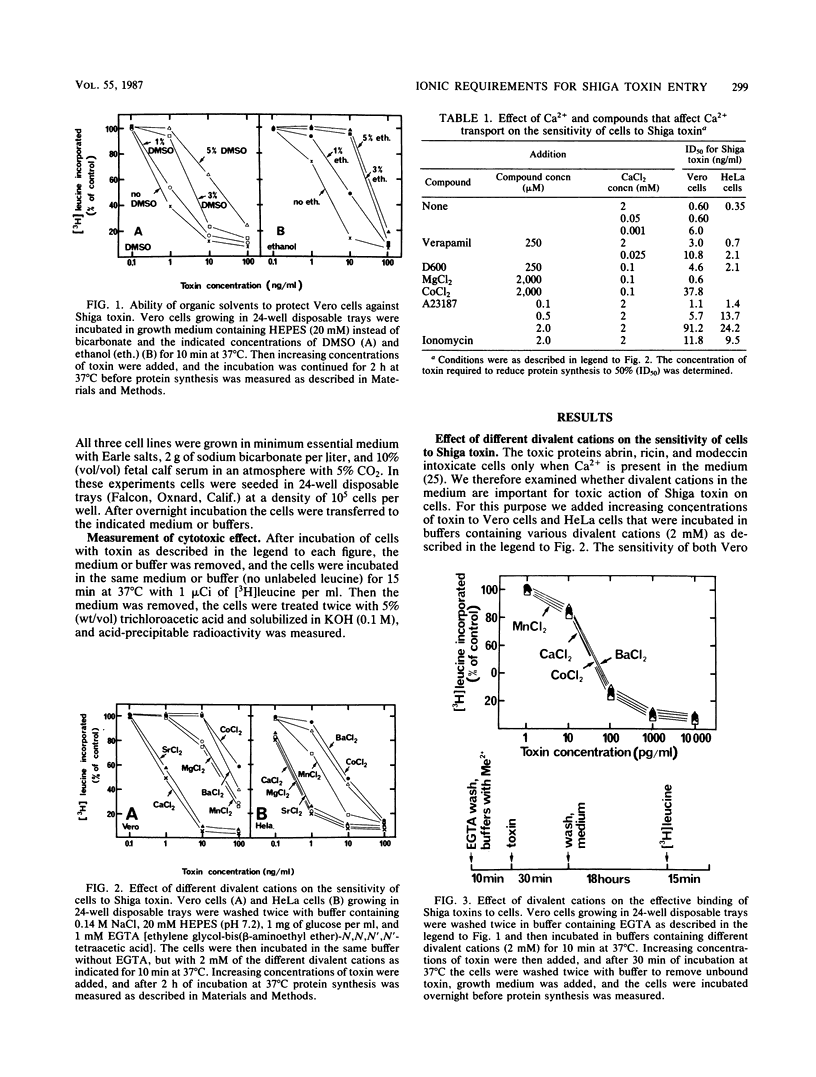
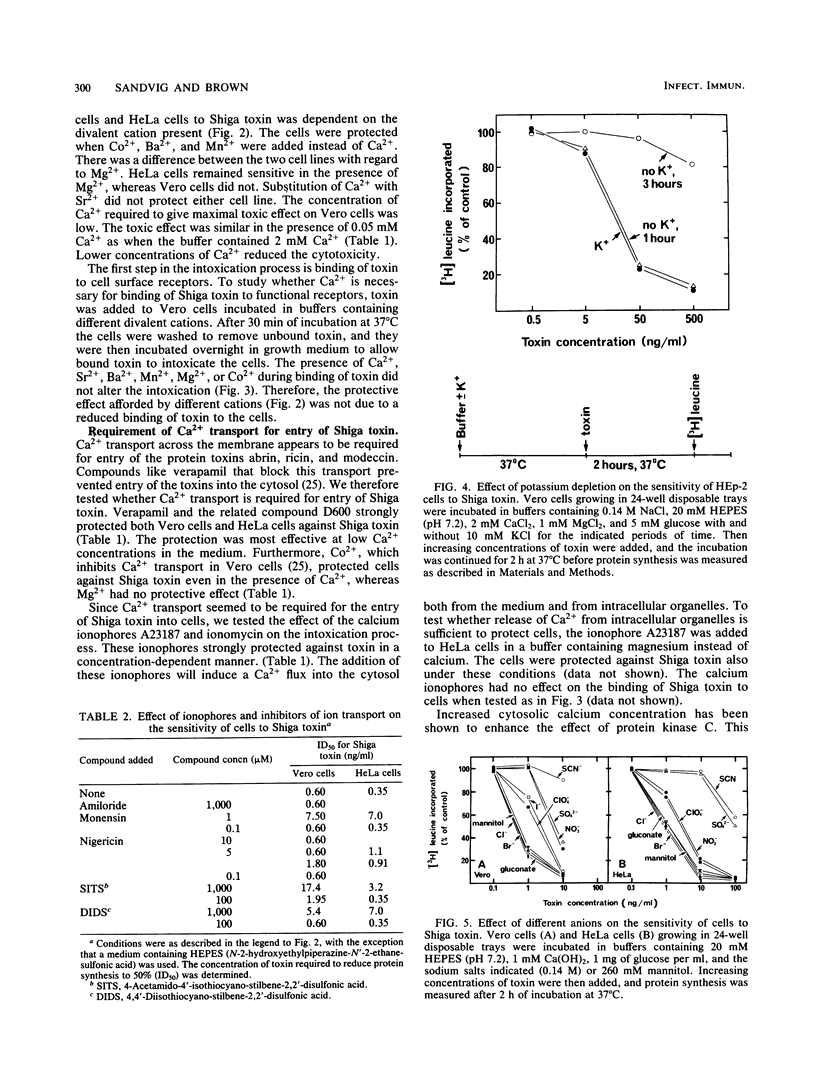
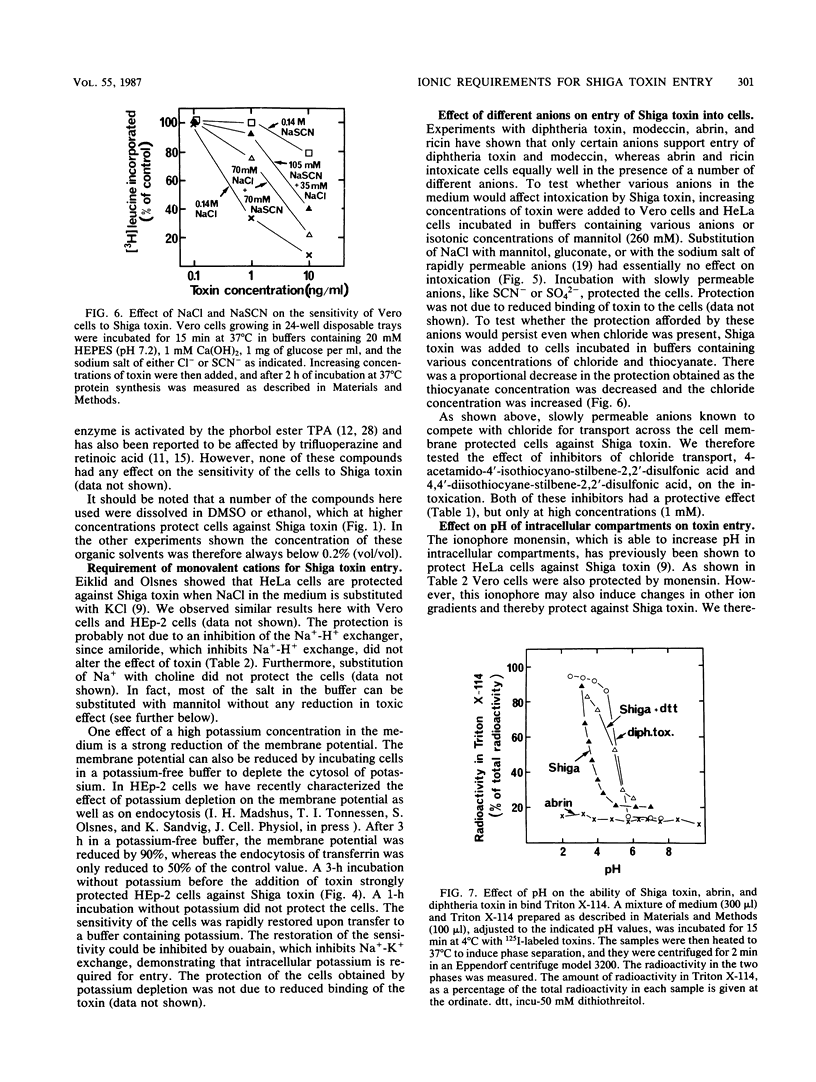
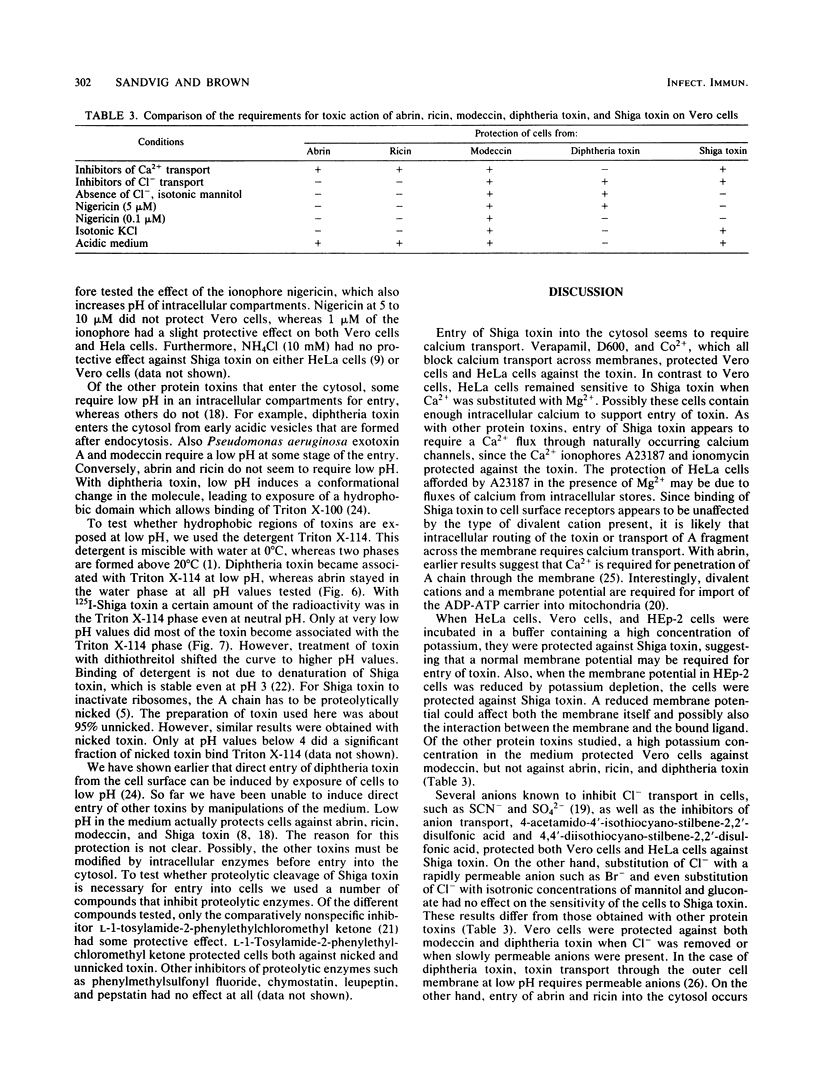
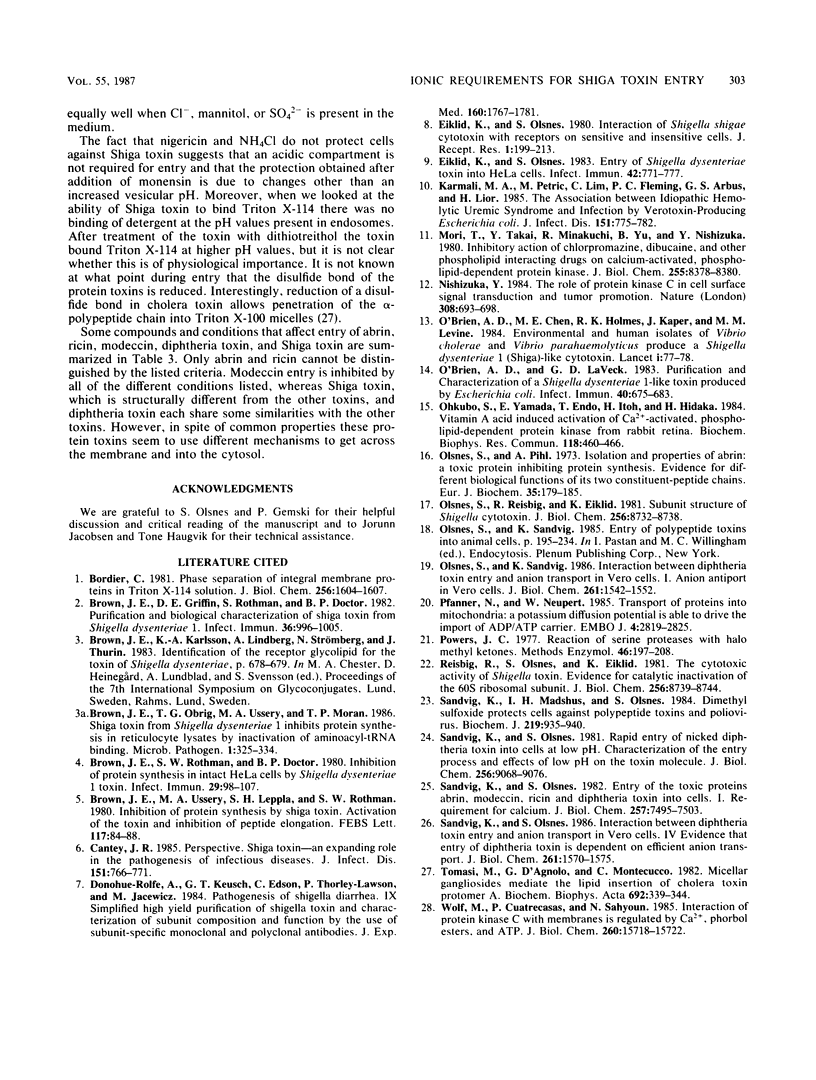
Selected References
These references are in PubMed. This may not be the complete list of references from this article.
- Bordier C. Phase separation of integral membrane proteins in Triton X-114 solution. J Biol Chem. 1981 Feb 25;256(4):1604–1607. [PubMed] [Google Scholar]
- Brown J. E., Griffin D. E., Rothman S. W., Doctor B. P. Purification and biological characterization of shiga toxin from Shigella dysenteriae 1. Infect Immun. 1982 Jun;36(3):996–1005. doi: 10.1128/iai.36.3.996-1005.1982. [DOI] [PMC free article] [PubMed] [Google Scholar]
- Brown J. E., Obrig T. G., Ussery M. A., Moran T. P. Shiga toxin from Shigella dysenteriae 1 inhibits protein synthesis in reticulocyte lysates by inactivation of aminoacyl-tRNA binding. Microb Pathog. 1986 Aug;1(4):325–334. doi: 10.1016/0882-4010(86)90065-3. [DOI] [PubMed] [Google Scholar]
- Brown J. E., Rothman S. W., Doctor B. P. Inhibition of protein synthesis in intact HeLa cells by Shigella dysenteriae 1 toxin. Infect Immun. 1980 Jul;29(1):98–107. doi: 10.1128/iai.29.1.98-107.1980. [DOI] [PMC free article] [PubMed] [Google Scholar]
- Brown J. E., Ussery M. A., Leppla S. H., Rothman S. W. Inhibition of protein synthesis by Shiga toxin: activation of the toxin and inhibition of peptide elongation. FEBS Lett. 1980 Aug 11;117(1):84–88. doi: 10.1016/0014-5793(80)80918-5. [DOI] [PubMed] [Google Scholar]
- Cantey J. R. Shiga toxin--an expanding role in the pathogenesis of infectious diseases. J Infect Dis. 1985 May;151(5):766–771. doi: 10.1093/infdis/151.5.766. [DOI] [PubMed] [Google Scholar]
- Donohue-Rolfe A., Keusch G. T., Edson C., Thorley-Lawson D., Jacewicz M. Pathogenesis of Shigella diarrhea. IX. Simplified high yield purification of Shigella toxin and characterization of subunit composition and function by the use of subunit-specific monoclonal and polyclonal antibodies. J Exp Med. 1984 Dec 1;160(6):1767–1781. doi: 10.1084/jem.160.6.1767. [DOI] [PMC free article] [PubMed] [Google Scholar]
- Eiklid K., Olsnes S. Entry of Shigella dysenteriae toxin into HeLa cells. Infect Immun. 1983 Nov;42(2):771–777. doi: 10.1128/iai.42.2.771-777.1983. [DOI] [PMC free article] [PubMed] [Google Scholar]
- Eiklid K., Olsnes S. Interaction of Shigella shigae cytotoxin with receptors on sensitive and insensitive cells. J Recept Res. 1980;1(2):199–213. doi: 10.3109/10799898009044098. [DOI] [PubMed] [Google Scholar]
- Karmali M. A., Petric M., Lim C., Fleming P. C., Arbus G. S., Lior H. The association between idiopathic hemolytic uremic syndrome and infection by verotoxin-producing Escherichia coli. J Infect Dis. 1985 May;151(5):775–782. doi: 10.1093/infdis/151.5.775. [DOI] [PubMed] [Google Scholar]
- Mori T., Takai Y., Minakuchi R., Yu B., Nishizuka Y. Inhibitory action of chlorpromazine, dibucaine, and other phospholipid-interacting drugs on calcium-activated, phospholipid-dependent protein kinase. J Biol Chem. 1980 Sep 25;255(18):8378–8380. [PubMed] [Google Scholar]
- Nishizuka Y. The role of protein kinase C in cell surface signal transduction and tumour promotion. Nature. 1984 Apr 19;308(5961):693–698. doi: 10.1038/308693a0. [DOI] [PubMed] [Google Scholar]
- O'Brien A. D., Chen M. E., Holmes R. K., Kaper J., Levine M. M. Environmental and human isolates of Vibrio cholerae and Vibrio parahaemolyticus produce a Shigella dysenteriae 1 (Shiga)-like cytotoxin. Lancet. 1984 Jan 14;1(8368):77–78. doi: 10.1016/s0140-6736(84)90006-0. [DOI] [PubMed] [Google Scholar]
- O'Brien A. D., LaVeck G. D. Purification and characterization of a Shigella dysenteriae 1-like toxin produced by Escherichia coli. Infect Immun. 1983 May;40(2):675–683. doi: 10.1128/iai.40.2.675-683.1983. [DOI] [PMC free article] [PubMed] [Google Scholar]
- Ohkubo S., Yamada E., Endo T., Itoh H., Hidaka H. Vitamin A acid-induced activation of Ca2+-activated, phospholipid-dependent protein kinase from rabbit retina. Biochem Biophys Res Commun. 1984 Jan 30;118(2):460–466. doi: 10.1016/0006-291x(84)91325-1. [DOI] [PubMed] [Google Scholar]
- Olsnes S., Pihl A. Isolation and properties of abrin: a toxic protein inhibiting protein synthesis. Evidence for different biological functions of its two constituent-peptide chains. Eur J Biochem. 1973 May;35(1):179–185. doi: 10.1111/j.1432-1033.1973.tb02823.x. [DOI] [PubMed] [Google Scholar]
- Olsnes S., Reisbig R., Eiklid K. Subunit structure of Shigella cytotoxin. J Biol Chem. 1981 Aug 25;256(16):8732–8738. [PubMed] [Google Scholar]
- Olsnes S., Sandvig K. Interactions between diphtheria toxin entry and anion transport in Vero cells. I. Anion antiport in Vero cells. J Biol Chem. 1986 Feb 5;261(4):1542–1552. [PubMed] [Google Scholar]
- Pfanner N., Neupert W. Transport of proteins into mitochondria: a potassium diffusion potential is able to drive the import of ADP/ATP carrier. EMBO J. 1985 Nov;4(11):2819–2825. doi: 10.1002/j.1460-2075.1985.tb04009.x. [DOI] [PMC free article] [PubMed] [Google Scholar]
- Powers J. C. Reaction of serine proteases with halomethyl ketones. Methods Enzymol. 1977;46:197–208. doi: 10.1016/s0076-6879(77)46020-8. [DOI] [PubMed] [Google Scholar]
- Reisbig R., Olsnes S., Eiklid K. The cytotoxic activity of Shigella toxin. Evidence for catalytic inactivation of the 60 S ribosomal subunit. J Biol Chem. 1981 Aug 25;256(16):8739–8744. [PubMed] [Google Scholar]
- Sandvig K., Madshus I. H., Olsnes S. Dimethyl sulphoxide protects cells against polypeptide toxins and poliovirus. Biochem J. 1984 May 1;219(3):935–940. doi: 10.1042/bj2190935. [DOI] [PMC free article] [PubMed] [Google Scholar]
- Sandvig K., Olsnes S. Entry of the toxic proteins abrin, modeccin, ricin, and diphtheria toxin into cells. I. Requirement for calcium. J Biol Chem. 1982 Jul 10;257(13):7495–7503. [PubMed] [Google Scholar]
- Sandvig K., Olsnes S. Interactions between diphtheria toxin entry and anion transport in Vero cells. IV. Evidence that entry of diphtheria toxin is dependent on efficient anion transport. J Biol Chem. 1986 Feb 5;261(4):1570–1575. [PubMed] [Google Scholar]
- Sandvig K., Olsnes S. Rapid entry of nicked diphtheria toxin into cells at low pH. Characterization of the entry process and effects of low pH on the toxin molecule. J Biol Chem. 1981 Sep 10;256(17):9068–9076. [PubMed] [Google Scholar]
- Tomasi M., D'Agnolo G., Montecucco C. Micellar gangliosides mediate the lipid insertion of cholera toxin protomer A. Biochim Biophys Acta. 1982 Nov 22;692(3):339–344. doi: 10.1016/0005-2736(82)90382-0. [DOI] [PubMed] [Google Scholar]
- Wolf M., Cuatrecasas P., Sahyoun N. Interaction of protein kinase C with membranes is regulated by Ca2+, phorbol esters, and ATP. J Biol Chem. 1985 Dec 15;260(29):15718–15722. [PubMed] [Google Scholar]


